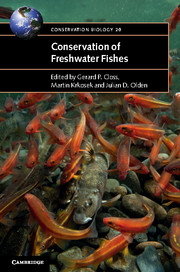Book contents
- Frontmatter
- Contents
- List of contributors
- Preface
- 1 Lost fishes, who is counting? The extent of the threat to freshwater fish biodiversity
- 2 Why are freshwater fish so threatened?
- 3 Climate change effects on freshwater fishes, conservation and management
- 4 Challenges and opportunities for fish conservation in dam-impacted waters
- 5 Chemical pollution
- 6 Multiple stressor effects on freshwater fish: a review and meta-analysis
- 7 Infectious disease and the conservation of freshwater fish
- 8 Non-indigenous fishes and their role in freshwater fish imperilment
- 9 Riparian management and the conservation of stream ecosystems and fishes
- 10 Fragmentation, connectivity and fish species persistence in freshwater ecosystems
- 11 Conservation of migratory fishes in freshwater ecosystems
- 12 Protecting apex predators
- 13 Artificial propagation of freshwater fishes: benefits and risks to recipient ecosystems from stocking, translocation and re-introduction
- 14 Freshwater conservation planning
- 15 Sustainable inland fisheries – perspectives from the recreational, commercial and subsistence sectors from around the globe
- 16 Understanding and conserving genetic diversity in a world dominated by alien introductions and native transfers: the case study of primary and peripheral freshwater fishes in southern Europe
- 17 Maintaining taxonomic skills; the decline of taxonomy – a threat to fish conservation
- 18 Synthesis – what is the future of freshwater fishes?
- Index
- References
11 - Conservation of migratory fishes in freshwater ecosystems
Published online by Cambridge University Press: 05 December 2015
- Frontmatter
- Contents
- List of contributors
- Preface
- 1 Lost fishes, who is counting? The extent of the threat to freshwater fish biodiversity
- 2 Why are freshwater fish so threatened?
- 3 Climate change effects on freshwater fishes, conservation and management
- 4 Challenges and opportunities for fish conservation in dam-impacted waters
- 5 Chemical pollution
- 6 Multiple stressor effects on freshwater fish: a review and meta-analysis
- 7 Infectious disease and the conservation of freshwater fish
- 8 Non-indigenous fishes and their role in freshwater fish imperilment
- 9 Riparian management and the conservation of stream ecosystems and fishes
- 10 Fragmentation, connectivity and fish species persistence in freshwater ecosystems
- 11 Conservation of migratory fishes in freshwater ecosystems
- 12 Protecting apex predators
- 13 Artificial propagation of freshwater fishes: benefits and risks to recipient ecosystems from stocking, translocation and re-introduction
- 14 Freshwater conservation planning
- 15 Sustainable inland fisheries – perspectives from the recreational, commercial and subsistence sectors from around the globe
- 16 Understanding and conserving genetic diversity in a world dominated by alien introductions and native transfers: the case study of primary and peripheral freshwater fishes in southern Europe
- 17 Maintaining taxonomic skills; the decline of taxonomy – a threat to fish conservation
- 18 Synthesis – what is the future of freshwater fishes?
- Index
- References
Summary
Migratory fishes are natural wonders. For many people, the term migratory fish evokes images of salmon audaciously jumping at waterfalls as they return to their own riverine birthplace to spawn after years of growth in the ocean, but freshwater fishes actually show a broad spectrum of migration strategies. Migratory fishes include small species – three-spined sticklebacks that spawn in coastal streams around the northern Pacific and gobies that move from the ocean into tropical island streams by climbing waterfalls (McDowall, 1988) – as well as some of the largest freshwater fishes in the world, such as the Mekong dog-eating catfish and the Chinese paddlefish (Stone, 2007). Aside from migratory habits, these species have few shared characteristics; they encompass numerous evolutionary lineages, enormous differences in life history, and every possible direction and distance of migration. Biologists treat migratory freshwater fishes as a functional group because their life-history strategy revolves around long-distance movement between ecosystems in a perilous quest to take advantage of both high-quality breeding sites and bountiful feeding areas. As humans have physically blocked fish migrations, degraded breeding and feeding grounds and relentlessly harvested migrants for their flesh and roe, many populations have declined or been extirpated. This chapter will provide an overview of fundamental and applied research that is helping to guide efforts to conserve migratory freshwater fishes.
For practical purposes, we define migratory behaviour as the synchronized movement of a substantial proportion of a population between distinct habitats, which is repeated through time within or across generations. Modern definitions of fish migrations typically recognise both the adaptive benefits of migrating and individual variation in executing the general strategy (see McDowall, 1988; Lucas & Baras, 2001). Not every individual must move, the timing may vary somewhat from year to year, and the motive for migrating may include seeking refuge from harsh conditions in addition to breeding and feeding. Nonetheless, in most cases, migration is critical to individual fitness and population persistence because it enables specialised use of different habitats for growth and reproduction. Where their migration routes are blocked or key habitats are lost, migratory fishes often suffer rapid and catastrophic losses.
Human appropriation and degradation of the Earth's freshwater ecosystems (Vörösmarty et al., 2010; Carpenter et al., 2011) have transformed this reliance on multiple habitats into a detriment for many migratory fishes.
- Type
- Chapter
- Information
- Conservation of Freshwater Fishes , pp. 324 - 360Publisher: Cambridge University PressPrint publication year: 2015
References
- 30
- Cited by



